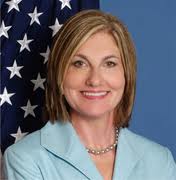If you weren't among the little more than 1,000 credit unionindustry executives, volunteers and vendors who attended NAFCU's 46th Annual Conference in Boston last week,you missed out on these four important takeaways:
|1. Becker's cancer scare
|President/CEO Fred Becker stunned conference goers – includingmembers of his own board – during his farewell speech when he announced he had privately  battled cancer during the financial crisis. Becker wasdiagnosed with bladder cancer in January 2009, shortly afterparticipating in President Barack Obama's inauguration.
battled cancer during the financial crisis. Becker wasdiagnosed with bladder cancer in January 2009, shortly afterparticipating in President Barack Obama's inauguration.
Despite being otherwise healthy and fit, Becker was told hiscancer was invasive, a high-grade Stage II or III with a survivalrate of just 50% over the next five years. Unbeknownst to the vastmajority of the industry, Becker managed NAFCU through thecorporate crisis and Great Recession – including theconservatorship of U.S. Central and Western Corporate FCU – whilesimultaneously undergoing chemotherapy, surgery, multiple emergencyroom visits, procedures, and intense personal introspection.
|He shared how when facing crossroads in life, challenges must bemet head on with tenacity, resilience and adaptability. Beckerretires from NAFCU July 31 after 13 years leading theorganization.
|Next: Matz Talks Risk-Based Net Worth Rule 2. Risk-based net worth rule under development
|The topic had been mentioned in passing earlier this year, butChairman Debbie Matz made it official during her Friday generalsession address: the federal regulator is developing new risk-basedcapital requirements that will be proposed in 2013.
| Matz said the current 7% net worth requirement wouldremain the floor requirement for credit unions with little risk intheir balance sheets.
Matz said the current 7% net worth requirement wouldremain the floor requirement for credit unions with little risk intheir balance sheets.
However, credit unions with more than $50 million in assetswould be subject to higher risk-based net worth requirements basedupon their risk profile. In an educational breakout sessionfollowing Matz's speech, former NCUA Board Chairman Dennis Dollarcautioned against placing too many restrictions on large creditunions that carry more risk, because as an asset class, theygenerate far better returns than small credit unions.
|And, Dollar said, net profits are the only way credit unions canbuild net worth.
|Next: Dollar Disses Merger Rules
|3. NCUA merger rules put SIF at risk
|When it comes to mergers, NCUA rules put the share insurance fund at risk
| During his breakout session, former NCUA Board ChairmanDennis Dollar said for federally chartered credit unions, therequirement that they share common fields of membership is thesingle biggest hurdle in approving mergers.
During his breakout session, former NCUA Board ChairmanDennis Dollar said for federally chartered credit unions, therequirement that they share common fields of membership is thesingle biggest hurdle in approving mergers.
The NCUA could be more flexible with the rule, Dollar said, butthe regulator faces constant legal pressure from bankers whothreaten to sue over claims the NCUA approves mergers as a way tocircumvent field of membership regulations. The result, Dollarsaid, is an inability to approve a merger with a troubled creditunion until net worth falls to 3%, triggering involuntary mergerrules that can waive the FOM requirement.
|“If you have to wait until 3% before the NCUA is willing tomerge them, you don't want them anymore,” he said. “You would havetaken them at 7% while on the way down to 3%, but once they're at3%, you'll say, 'no thanks'.”
|That lack of interested parties puts the share insurance fund atrisk when the NCUA is forced to liquidate the credit union, ornegotiate a loss guarantee with a willing merger partner. Even inthe case of Arrowhead Credit Union, which was released from conservatorship earlier this year and returned tothe control of its members, Dollar said, “it's not nearly thecredit union it used to be.”
|Next: QM Rule Roils Mortgage LoanProfitability
||4. Mortgagesrendered unprofitable by QM rule
|During a breakout session, Jeff Schwalen, president/CEO of the St. Paul, Minn.-based HiwayFCU, said Consumer Financial Protection Bureau limits on closingcosts make complying with the bureau's qualified mortgage ruleunprofitable.
Because QM loans are limited to closing costs of 3% of the loanbalance, lenders in parts of the country with relatively low homevalues can't generate enough fee income to cover their costs, hesaid.
|For example, for a $50,000 mortgage loan, Schwalen said, actualcosts in Minnesota are $2,613. However, 3% of that balance is just$1,500, resulting in a $1,113 net loss on the loan. A $135,000mortgage would bring in a maximum of $4,050 in closing costs, butcosts the $918 million credit union $75 more to make the loan.
|In comparison, a $400,000 mortgage could generate up to $12,000in closing costs and still comply with the QM 3% closing costslimit. While that would produce a $3,307 net profit, mortgages ofthat size aren't common in the Midwest. In fact, the averagemortgage loan amount in Minnesota is just $180,000, he said.
|Schwalen said his credit union will make non-QM loans and holdthem on the books. Not only will the strategy help fill a void inthe marketplace, Schwalen said he can manage interest rate riskbecause the loans will have relatively low outstandingbalances.
|Also at NAFCU Confab:
- Becker Calls it a Wrap
- Dollar Says Let Golden GooseLive
- Matz Reveals New Risk Rule
- Thursday in Pictures
- Non-Interest Income Balance
- Berger Promises Training Boost
- CFPB is Good for You
- Beantown Vox Populi
- Wednesday in Pictures
- Non-QMs Offer Opportunity
- Managing Outsourced Collections
- Losing Money at Loan Closings
- New Officers for 2013-2014
Complete your profile to continue reading and get FREE access to CUTimes.com, part of your ALM digital membership.
Your access to unlimited CUTimes.com content isn’t changing.
Once you are an ALM digital member, you’ll receive:
- Critical CUTimes.com information including comprehensive product and service provider listings via the Marketplace Directory, CU Careers, resources from industry leaders, webcasts, and breaking news, analysis and more with our informative Newsletters.
- Exclusive discounts on ALM and CU Times events.
- Access to other award-winning ALM websites including Law.com and GlobeSt.com.
Already have an account? Sign In
© 2024 ALM Global, LLC, All Rights Reserved. Request academic re-use from www.copyright.com. All other uses, submit a request to [email protected]. For more information visit Asset & Logo Licensing.









